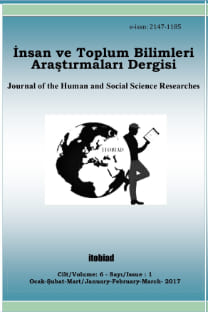Hansel ve Gretel Adlı Masalın Greimas’ın Eyleyenler Modeline Göre İncelenmesi
Masal, Saussure, Propp, Greimas, göstergebilim, eyleyenler modeli, Hansel ve Gretel
Analysis of the Fairy Tale Hansel and Gretel According to Actantial Model of Greimas
Fairy tale, Saussure, Propp, Greimas, Semiotics, Actantial Model, Hansel and Gretel,
___
- Asutay, H. (2013). Çocuk Yazınının Fantastik Dünyası: Masallar. Turkish Studies, 8(13), 265-278.
- Erkman-Akerson, F. (2005). Göstergebilime Giriş. İstanbul: Multilingual
- Grimm, J. & W. (2011). Grimm Masalları, s.18-23. (E. Portakal, Çev.). İstanbul: Bilge Kirpi Yayıncılık.
- Günay, U. T. (2011). Elazığ Masalları ve Propp Metodu. Ankara: Akçağ
- Kıran A. & Z. (2011). Yazınsal Okuma Süreçleri. Ankara: Seçkin Yayıncılık.
- Parsa, S & A. F. (2004). Göstergebilim Çözümlemeleri. İzmir: Ege Üniversitesi Basımevi.
- Propp, V. (1968). Morphology of the Folktale. Austin: University of Texas Press
- Rifat, M. (2007). Homo Semioticus ve Genel Göstergebilim Sorunları. İstanbul: Yapı Kredi Yayınları.
- Rifat, M. (2013). XX. Yüzyılda Dilbilim ve Göstergebilim Kuramları. İstanbul: Yapı Kredi Yayınları.
- Rifat, M. (2009). Göstergebilimin ABC’si. İstanbul: Say Yayınları.
- Saussure, F. (1959). Course in General Linguistics. New York: Philosophical Library
- Şirin, M. R. (2007). Masal Atlası: Masal Edebiyatı Kültürü Üzerine Yazılar. Ankara: Kök Yayıncılık
- Yücel, T. (1982). Yapısalcılık. İstanbul: Ada Yayınları
- Zipes, J. (2003).The Brothers Grimm: From Enchanted Forests to the Modern World. New York: Palgrave Macmillan.
- ISSN: 2147-1185
- Yayın Aralığı: 4
- Başlangıç: 2012
- Yayıncı: Mustafa SÜLEYMAN ÖZCAN
İslam Ahlâk Düşüncesinde Erdemler: Şehrezûrî Örneği1
JİNEKOLOJİK KANSERLER FARKINDALIK ÖLÇEĞİ GELİŞTİRME ÇALIŞMASI
Ravzatu’l-Ukûl Adlı Eserde Geçen Mesel Örneklerine Dair Bir İnceleme
Yabancı Uyruklu Öğrencilerin Sosyo-Kültürel Entegrasyonu (Karabük Üniversitesi Örneği)
Y. Sinan ZAVALSIZ, Emine GÜNDAĞ
Kant'ta Aritmetik Yargıların Doğası Üzerine Bir İnceleme
Kendini Bilme ve Psikolojik İyi Oluş Arasındaki İlişkinin İncelenmesi
İBRAHİM DEMİRCİ, ALİ HAYDAR ŞAR
Ortaöğretim Tarih Derslerinde Tarihi Filmlerin Değer Eğitiminde Kullanımı
